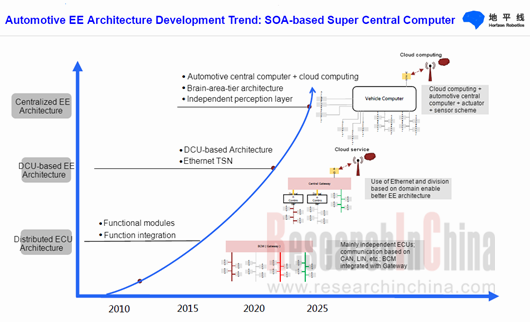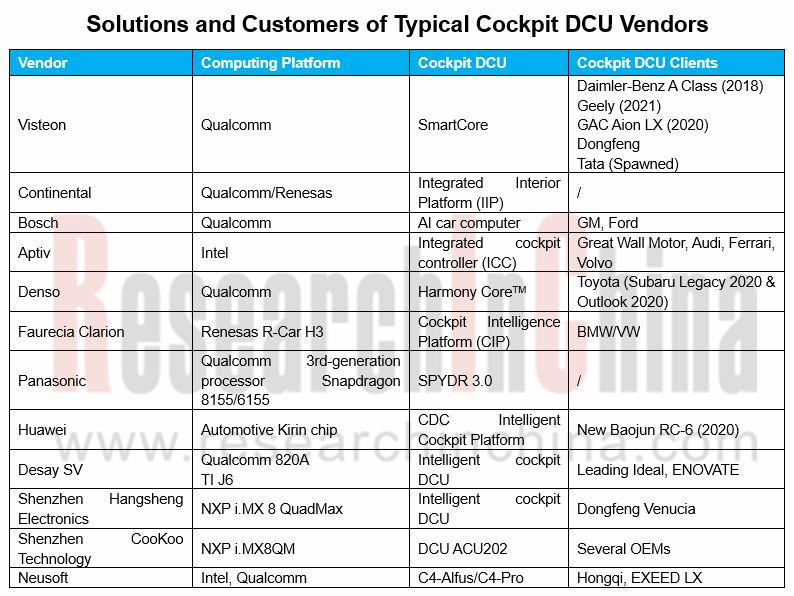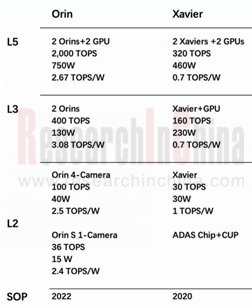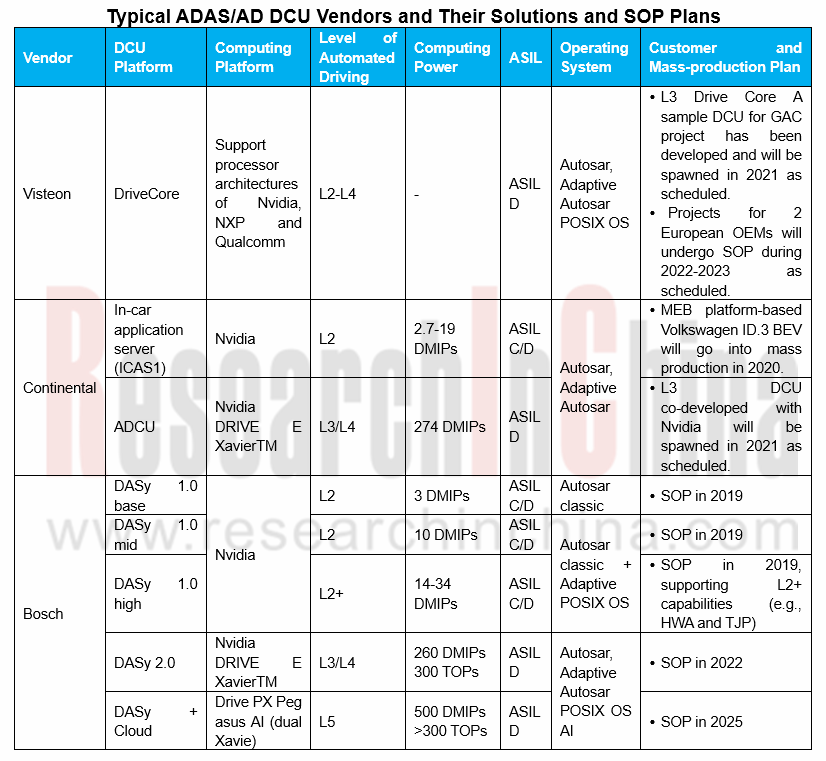Domain control unit shipments will boom in 2021.
When the one-to-one correspondence between the growing number of sensors and electronic control units (ECU) leads to underperforming vehicles and adds circuit complexity, more powerful centralized architectures like domain control unit (DCU) and multi-domain controller (MDC) come as an alternative to the distributed ones.
As concerns the tendency of domain controller, Vector conceives three stages of E/E architecture development: controller-centric, DCU, and central computer. Intelligent vehicle will ultimately be a mobile super computer and data center, and a new Wintel will come into being. In future, computing platform, operating system and application software will matter the most to the highly automated vehicles; multimedia multi-domain controllers and central domain controllers are likely to be combined into one.

In response to the disruption, Volkswagen plans adoption of a unified automotive E/E architecture; BMW will introduce central communication services and service-oriented architecture (SOA) in its next-generation E/E architecture; the smart vehicle architecture (SVA) launched by Aptiv breaks the bottleneck of conventional architectures, providing frame scalability for next-generation intelligent vehicles. The new E/E architectures will be built on the concept of central computer-layer-area, embodying the philosophy of SOA.
As to DCU, next-generation smart cockpit system based on cockpit DCU enables functionality of cockpit electronic system on a unified software and hardware platform. Cockpit electronic system offering intelligent interaction and scenarios as well as personalized services, will be a foundation for human-vehicle interaction and vehicle-to-everything (V2X) communication. Visteon argues that by 2023, intelligent cockpit integrated with LCD dashboard, center console and co-pilot infotainment system will be based entirely on single-ECU domain control platform.
Globally, Visteon, Continental, Bosch and Aptiv dominate the cockpit DCU market; Chinese players like Huawei, Desay SV, Shenzhen Hangsheng Electronics and Neusoft race to unveil their cockpit DCU solutions.
As for cockpit chip, typical products are comprised of Qualcomm 820A, Intel Atom, NXP i.MX8, Renesas R-CAR H3 and TI Jacinto family. Notably, the prevailing Qualcomm 820A processor platform has been ordered by 18 out of the 25 world-renowned OEMs, with the order intake recording $5.5 billion or so.

In the ADAS/AD DCU market, most of those in use for Level 1 driving assistance employ separate ECU to control. ADAS ECU which is developed mainly for Level 2 driving assistance is utilized to combine LDW/LKA and AEB. It is in the era of Level 2+, Level 3 and Level 4 automated driving that the demand for autonomous driving domain control unit (AD DCU) will be soaring.
Tier-1 suppliers worldwide already deploy ADAS/AD DCU such as Visteon DriveCore, Bosch DASy, Continental ADCU, ZF ProAI, Veoneer Zeus and Magna MAX4. In China, such typical products include iECU (co-developed by SAIC and TTTech), Huawei MDC (MobileData Center) intelligent driving DCU, IN-DRIVING TITAN, and Neusoft Reach CPDC-II DCU/CPDC-III central computer.
When it comes to autonomous driving chip, Nvidia is absolutely the leader with Nvidia Drive PX2 and Nvidia Drive Xavier being widely deployed by vendors. In December 2019, Nvidia introduced DRIVE AGX Orin, a software-defined platform for Level 5 automated driving, with nearly 7x the performance of the previous generation SoC Xaiver. The Orin SoC integrates NVIDIA’s next-generation GPU architecture and Arm Hercules CPU cores, as well as new deep learning and computer vision accelerators that, in aggregate, deliver 2,000 TOPS.

Other autonomous driving chips include TI TDA4, Qualcomm? Snapdragon Ride?, NXP S32 family, and Mobileye EyeQ family.

In the next three to five years, among DCU market segments, cockpit DCU will see a faster growth rate and a larger market than autonomous driving DCU because it is easier to spawn cockpit DCUs at lower cost; the surging demand for intelligent cockpits, which is fueled by the availability of 5G in vehicles, will drive up cockpit DCU shipments to explode in 2021 on the basis of OEM’s and Tier1’s progress in mass production.
In the ADAS/AD DCU field, inadequate regulations and immature technologies will expectedly make it hard to apply Level 3/Level 4 automated driving technologies on large scale in the upcoming three to five years. OEMs, tier-1 suppliers and chip vendors are working to mass produce L2+ autonomous vehicles. It is predicted that production of Level 3/Level 4 autonomous vehicles will peak around 2025, but business-oriented vehicles will play the key role, with roughly 5 million units of ADAD/AD DCUs for passenger cars to be shipped worldwide in 2025.
China Automotive Lighting and Ambient Lighting System Research Report, 2025
Automotive Lighting System Research: In 2025H1, Autonomous Driving System (ADS) Marker Lamps Saw an 11-Fold Year-on-Year Growth and the Installation Rate of Automotive LED Lighting Approached 90...
Ecological Domain and Automotive Hardware Expansion Research Report, 2025
ResearchInChina has released the Ecological Domain and Automotive Hardware Expansion Research Report, 2025, which delves into the application of various automotive extended hardware, supplier ecologic...
Automotive Seating Innovation Technology Trend Research Report, 2025
Automotive Seating Research: With Popularization of Comfort Functions, How to Properly "Stack Functions" for Seating?
This report studies the status quo of seating technologies and functions in aspe...
Research Report on Chinese Suppliers’ Overseas Layout of Intelligent Driving, 2025
Research on Overseas Layout of Intelligent Driving: There Are Multiple Challenges in Overseas Layout, and Light-Asset Cooperation with Foreign Suppliers Emerges as the Optimal Solution at Present
20...
High-Voltage Power Supply in New Energy Vehicle (BMS, BDU, Relay, Integrated Battery Box) Research Report, 2025
The high-voltage power supply system is a core component of new energy vehicles. The battery pack serves as the central energy source, with the capacity of power battery affecting the vehicle's range,...
Automotive Radio Frequency System-on-Chip (RF SoC) and Module Research Report, 2025
Automotive RF SoC Research: The Pace of Introducing "Nerve Endings" such as UWB, NTN Satellite Communication, NearLink, and WIFI into Intelligent Vehicles Quickens
RF SoC (Radio Frequency Syst...
Automotive Power Management ICs and Signal Chain Chips Industry Research Report, 2025
Analog chips are used to process continuous analog signals from the natural world, such as light, sound, electricity/magnetism, position/speed/acceleration, and temperature. They are mainly composed o...
Global and China Electronic Rearview Mirror Industry Report, 2025
Based on the installation location, electronic rearview mirrors can be divided into electronic interior rearview mirrors (i.e., streaming media rearview mirrors) and electronic exterior rearview mirro...
Intelligent Cockpit Tier 1 Supplier Research Report, 2025 (Chinese Companies)
Intelligent Cockpit Tier1 Suppliers Research: Emerging AI Cockpit Products Fuel Layout of Full-Scenario Cockpit Ecosystem
This report mainly analyzes the current layout, innovative products, and deve...
Next-generation Central and Zonal Communication Network Topology and Chip Industry Research Report, 2025
The automotive E/E architecture is evolving towards a "central computing + zonal control" architecture, where the central computing platform is responsible for high-computing-power tasks, and zonal co...
Vehicle-road-cloud Integration and C-V2X Industry Research Report, 2025
Vehicle-side C-V2X Application Scenarios: Transition from R16 to R17, Providing a Communication Base for High-level Autonomous Driving, with the C-V2X On-board Explosion Period Approaching
In 2024, t...
Intelligent Cockpit Patent Analysis Report, 2025
Patent Trend: Three Major Directions of Intelligent Cockpits in 2025
This report explores the development trends of cutting-edge intelligent cockpits from the perspective of patents. The research sco...
Smart Car Information Security (Cybersecurity and Data Security) Research Report, 2025
Research on Automotive Information Security: AI Fusion Intelligent Protection and Ecological Collaboration Ensure Cybersecurity and Data Security
At present, what are the security risks faced by inte...
New Energy Vehicle 800-1000V High-Voltage Architecture and Supply Chain Research Report, 2025
Research on 800-1000V Architecture: to be installed in over 7 million vehicles in 2030, marking the arrival of the era of full-domain high voltage and megawatt supercharging.
In 2025, the 800-1000V h...
Foreign Tier 1 ADAS Suppliers Industry Research Report 2025
Research on Overseas Tier 1 ADAS Suppliers: Three Paths for Foreign Enterprises to Transfer to NOA
Foreign Tier 1 ADAS suppliers are obviously lagging behind in the field of NOA.
In 2024, Aptiv (2.6...
VLA Large Model Applications in Automotive and Robotics Research Report, 2025
ResearchInChina releases "VLA Large Model Applications in Automotive and Robotics Research Report, 2025": The report summarizes and analyzes the technical origin, development stages, application cases...
OEMs’ Next-generation In-vehicle Infotainment (IVI) System Trends Report, 2025
ResearchInChina releases the "OEMs’ Next-generation In-vehicle Infotainment (IVI) System Trends Report, 2025", which sorts out iterative development context of mainstream automakers in terms of infota...
Autonomous Driving SoC Research Report, 2025
High-level intelligent driving penetration continues to increase, with large-scale upgrading of intelligent driving SoC in 2025
In 2024, the total sales volume of domestic passenger cars in China was...